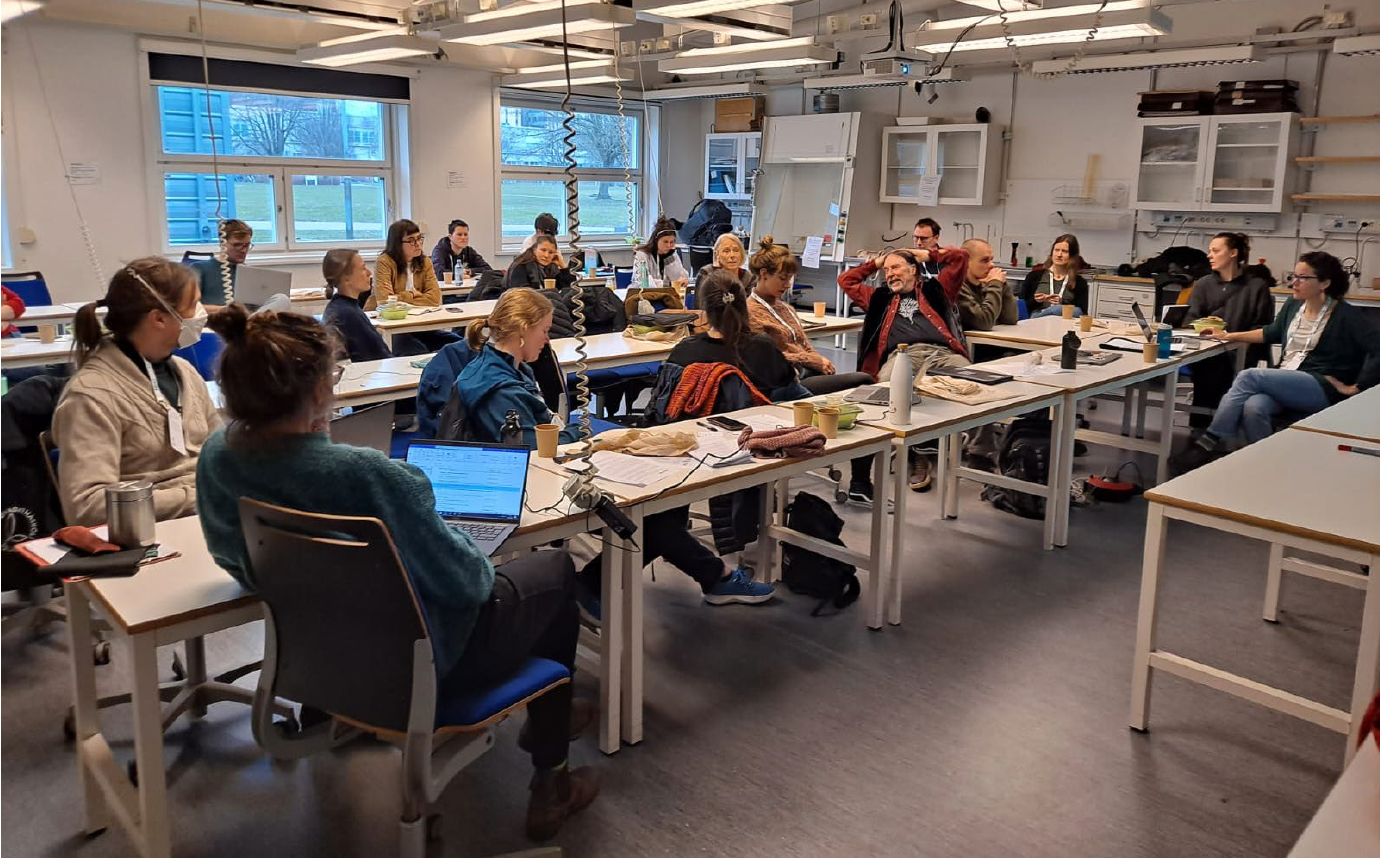Project Report (1/2)
During this Herbivory Network meeting a strong emphasis was placed on presentations by participants on their current research projects. As well, a field session included the demonstration of an observational protocol for data collection. We also had a brainstorming session on the potential contribution of Herbivory Network researchers to the ICARP IV process and an open public lecture attended by community members in Cambridge Bay.
 Highlights
Highlights
• After 10 years of contributing to circumpolar research on herbivory, since our first meeting at ASSW 2014 in Helsinki, the Herbivory Network continues to advance knowledge about the functioning of terrestrial Arctic ecosystems.
• The Herbivory Network 2023 meeting was organized at the Canadian High Arctic Research Station (CHARS) in Cambridge Bay, Nunavut, June 13-16, 2023, and was attended by eleven researchers from five Arctic countries and in different career stages.
• One of the legacies of the meeting will be a contribution to the ICARP IV process in the form of a horizon scanning exercise that will identify the top priorities for arctic herbivory research in the coming decade.
• A public lecture by Dr. Esther Lévesque from UQTR organized as part of the meeting welcomed community members from Cambridge Bay and presented research that had been co-developed with communities in the Canadian Arctic, focused on the ecology and harvest of berries.
Background about Herbivory Network
The Herbivory Network (HN) is a collaborative research initiative (http://herbivory.lbhi.is). Since its establishment in 2014, the HN has worked towards addressing the role of herbivory in Arctic and alpine ecosystems and developing new approaches to harmonise research efforts. The goal of HN is to foster collaborations within and across disciplines, facilitate multi-site comparisons, and work towards understanding the complexity and variability of responses of tundra ecosystems to herbivory.
Funding and support
Funding to organize the meeting was provided by the Terrestrial Working Group of IASC, supporting especially the participation of early career scientists. Transnational Access from INTERACT allowed researchers to participate in the meeting to demonstrate the implementation of the field protocol that will be used by researchers at their own field sites. Polar Knowledge Canada provided in-kind support, including accommodation, access to meeting facilities and logistics support. The Herbivory Network is a UArctic Thematic Network. Many of the discussions held during the meeting contribute to the TUNDRAsalad project (grant nr. 217754), funded by the Icelandic Research Fund.
(Photos courtesy of the organisers: Participants to the Herbivory Network meeting at the Canadian High Arctic research station in Cambridge Bay included, from left to right, Isabel Barrio (Agricultural University of Iceland), Stefaniya Kamenova (University of Oslo), Laura Barbero Palacios (Agricultural University of Iceland), Mathilde Defourneaux (Agricultural University of Iceland), Esther Lévesque (UQTR), Tiina Kolari (University of Eastern Finland), Noémie Boulanger-Lapointe (University of Victoria), Cléa Frapin (Université de Moncton), Nicolas Lecomte (Université de Moncton), Katrine Raundrup (Greenland Institute of Natural Resources). Photograph: David Hik, Polar Knowledge Canada and Simon Fraser University.)
Activity Report (2/2)
After 10 years of contributing to circumpolar research on plant-herbivore interactions, the Herbivory Network is using a horizon scan to identify research priorities in Arctic herbivory for the coming decade. As part of this process, the Herbivory Network organized a one-day in-person workshop, as a pre-conference activity, parallel to the Nordic Society Oikos conference held in Lund, March 12-15, 2024.
During the workshop, participants worked on refining the emerging themes and determining key action points for Arctic herbivory research in the next decade, based on feedback received from Arctic herbivory experts through an online survey. You can find more information about the project here.
 The workshop was organized by Isabel C Barrio (Agricultural University of Iceland), Stefaniya Kamenova (University of Oslo) and Helen Anderson (University of Aberdeen). Registration for the workshop was open through the portal of the NSO conference, ensuring a broader participation than from network members alone. A total of 26 researchers participated in the workshop, many of them early career scientists. The Herbivory Network workshop was organized as part of the activities of the Nordic Oikos Society conference 2024 held in Lund. The workshop took place in the Ecology Building of the University of Lund. A total of 26 researchers participated in the workshop (photo: Laura Barbero-Palacios)
The workshop was organized by Isabel C Barrio (Agricultural University of Iceland), Stefaniya Kamenova (University of Oslo) and Helen Anderson (University of Aberdeen). Registration for the workshop was open through the portal of the NSO conference, ensuring a broader participation than from network members alone. A total of 26 researchers participated in the workshop, many of them early career scientists. The Herbivory Network workshop was organized as part of the activities of the Nordic Oikos Society conference 2024 held in Lund. The workshop took place in the Ecology Building of the University of Lund. A total of 26 researchers participated in the workshop (photo: Laura Barbero-Palacios)
During the workshop a strong emphasis was placed on hands-on work and discussions, first in smaller groups, and then in the larger groups to try to reach consensus on the suggestions presented by the smaller groups. In the morning session, a brief introduction of the project was given by Isabel C Barrio, and workshop participants introduced themselves. Participants were split into four groups (5-8 participants each), led by Isabel C Barrio, Stefaniya Kamenova, Mathilde Defourneaux and Laura Barbero-Palacios. All groups were provided with a list of 146 questions compiled from the input received from the online surveys. The online surveys took place before the workshop, and included an initial elicitation of input by Arctic herbivory researchers, where researchers were asked to provide up to 5 questions they thought would be relevant in Arctic herbivory research in the coming decade. In a second step, after deduplicating questions and cleaning the database, researchers were asked to score the questions in terms of two criteria: their scientific relevance and their relevance to management. The list of questions provided to workshop participants was ranked based on this online scoring, and the top 25% for each criterion (scientific and management) were retained for further discussion. The groups were tasked with synthesizing the top-ranked questions in each criterion.
In the afternoon session, the four groups came back together to share and discuss their suggested synthesis. After the workshop, the conclusions will be summarized as a manuscript draft.
Background about Herbivory Network
The Herbivory Network (HN) is an international collaborative research initiative (http://herbivory.lbhi.is). Since its establishment in 2014, the HN has worked towards addressing the role of herbivory in Arctic and alpine ecosystems and developing new approaches to harmonise research efforts. The goal of HN is to foster collaborations within and across disciplines, facilitate multi-site comparisons, and work towards understanding the complexity and variability of responses of tundra ecosystems to herbivory. The Herbivory Network was endorsed as a UArctic Thematic Network in 2020.
Funding and support
This project has been endorsed by the International Arctic Science Committee as an ICARP IV activity. Funding to support the participation of early career scientists in this workshop has been made available by the Terrestrial Working Group of the International Arctic Science Committee (IASC). Many of the discussions held during the meeting contribute to the TUNDRAsalad project (grant nr. 217754), funded by the Icelandic Research Fund.
Highlights
• After 10 years of contributing to circumpolar research on plant-herbivore interactions, the Herbivory Network is using a horizon scan to identify research priorities in Arctic herbivory for the coming decade.
• A one-day workshop was organized in Lund on March 12 2024, parallel to the activities of the Nordic Society Oikos conference, and was attended by 26 researchers from seven Arctic countries and in different career stages.
• The legacy of the workshop will be a contribution to the ICARP IV process in the form of a horizon scanning exercise that identifies the top priorities for arctic herbivory research in the coming decade.
Date and Location:
13 – 16 June 2023 | Cambridge Bay, Nunavut, Canada and
12-15 March 2024| Lund, Sweden
IASC Working Group funding the Project:
- Terrestrial WG
Project Lead
Isabel C Barrio (Agricultural University of Iceland, Iceland)
Year funded by IASC
2023
Project Status
Completed
